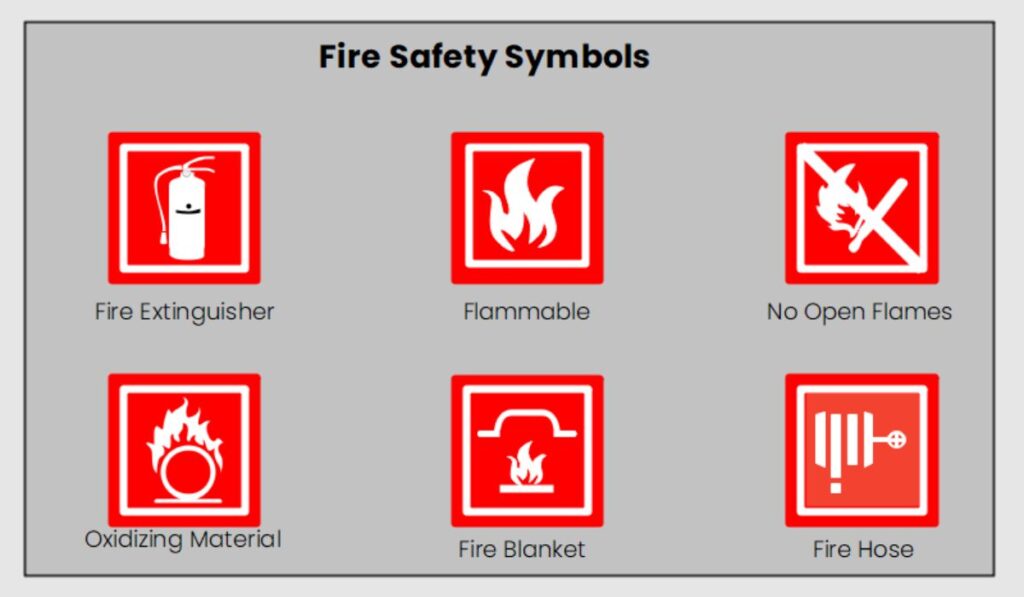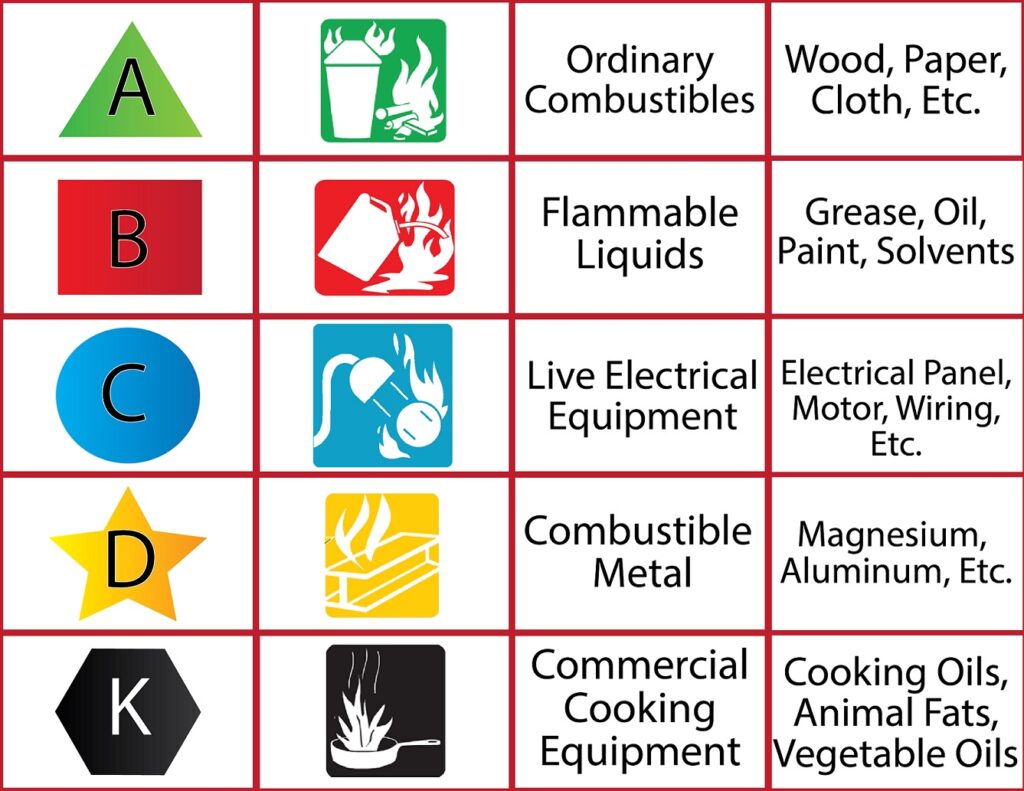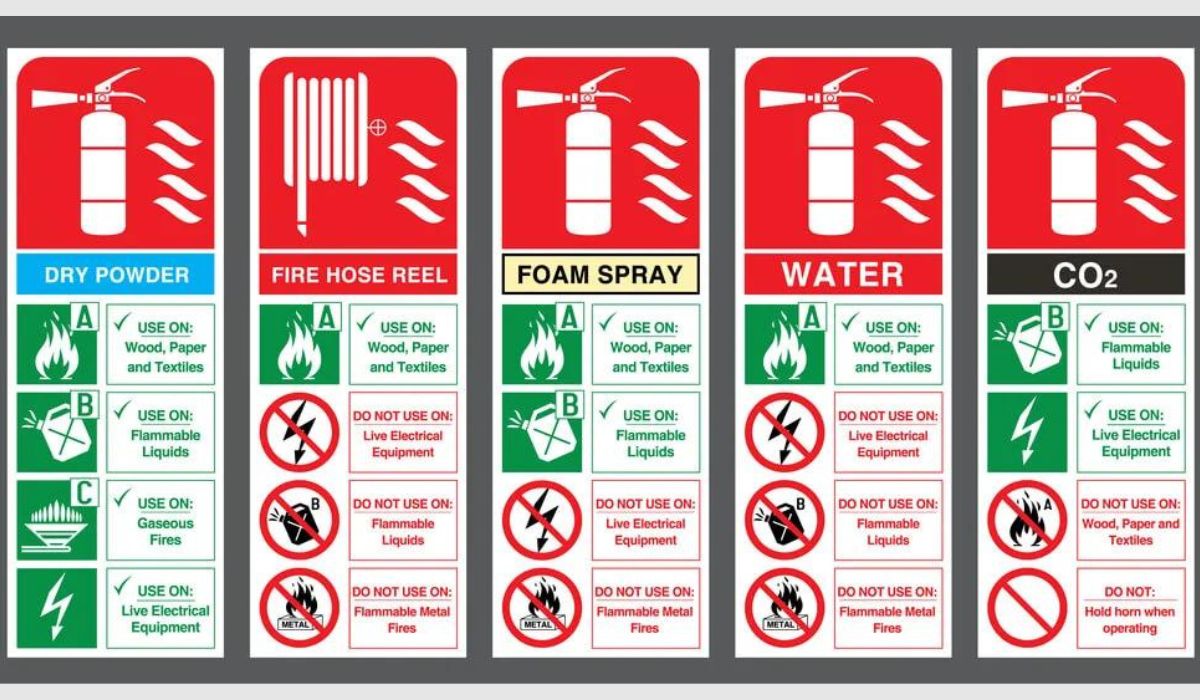The symbols on a fire extinguisher indicate the types of fires it is designed to fight. Pictograms demonstrate the extinguisher’s suitable use for classes of fires such as solids, liquids, or electrical.
Understanding the symbols on a fire extinguisher is crucial for effective and safe fire response. Each symbol or pictogram corresponds to a specific fire class—common classifications include Class A for ordinary combustibles, Class B for flammable liquids, Class C for electrical fires, Class D for metal fires, and Class K for kitchen fires.
Quick identification of these symbols can mean the difference between a controlled situation and a hazardous one. Fire extinguishers also display operational instructions and safety information through these symbols. For house owners, employees, and safety personnel, it’s essential to familiarize themselves with these indications for appropriate fire extinguisher usage, ensuring readiness in case of an emergency.

Deciphering Fire Extinguisher Symbols
Understanding the symbols on a fire extinguisher is critical. They communicate important information about the types of fires one can use the extinguisher on, and how to operate it effectively during an emergency. Join us as we break down these symbols to ensure you’re ready for any fire-related emergencies.
Colors And Their Meanings
Colors on fire extinguishers serve as quick references. Each color represents a different type of extinguishing agent and the class of fire it can combat.
| Color | Meaning |
|---|---|
| Red | Water – Fights class A fires |
| Cream | Foam – A & B fires |
| Blue | Powder – A, B, C & electrical fires |
| Black | Carbon Dioxide – B & electrical fires |
| Green | Wet Chemical – A & F fires |
Pictograms Explained
Familiarize with the pictograms on fire extinguishers. They illustrate the types of fires an extinguisher is designed to fight.
- A – Ash: For ordinary combustibles like wood and paper.
- B – Barrel: For flammable liquids like gasoline or oil.
- C – Circuit: For electrical equipment fires.
- D – Metal: For flammable metals; rare in household extinguishers.
- F – Frying pan: For cooking oils and fats.
Each pictogram is accompanied by a red slash through it if the extinguisher should not be used for that class of fire. This is as crucial as knowing the right ones to use.
Types Of Fires And Matching Extinguishers
Understanding the symbols on a fire extinguisher helps keep you prepared for any fire emergency. Like a guide in a perilous wild, these symbols lead to the right extinguisher for different types of fires, ensuring safety and efficiency.
Classification Of Fires
Fires are categorized based on the materials involved, which dictates the method for extinguishing them effectively.
| Fire Class | Fuel Source |
|---|---|
| A | Ordinary combustibles like wood, paper, and cloth |
| B | Flammable liquids like gasoline, oils, and fats |
| C | Electrical equipment |
| D | Metal fires involving magnesium, aluminum, etc. |
| K | Cooking oils and fats commonly found in kitchens |
Matching The Extinguisher To The Fire Class
To ensure you grab the correct extinguisher during an emergency, match it to the fire’s classification.
- Class A – symbolized by a green triangle, use on ordinary combustibles
- Class B – represented by a red square, tackle flammable liquid fires
- Class C – denoted by a blue circle, designed for electrical fires
- Class D – marked by a yellow decagon, for combustible metal fires
- Class K – indicated with a black hexagon, optimal for cooking fires
Extinguishers often cover multiple classes, so always check the labels closely. For versatile options, multi-class extinguishers, with symbols for each applicable class, are available.
Symbols Insight
“Symbols Insight” guides us through the language of fire safety. Each symbol on a fire extinguisher provides vital information. These symbols tell us what type of fire the extinguisher can tackle. It’s like having a cheat sheet for an exam — but this one saves lives.
The Abcs On Extinguishers
Understanding the ABCs on fire extinguishers is essential. These letters represent the classes of fire. Here’s a quick breakdown:
- A stands for ‘ashes’, which means common combustibles like wood and paper.
- B points to ‘barrels’ with flammable liquids like oil or gasoline.
- C indicates ‘circuits’ that refer to electrical fires.
Some extinguishers cover multiple classes, such as ABC extinguishers, which can combat a range of fires.
Special Symbols For Specific Fires
Besides the ABCs, there are symbols for more specific fires. They appear as icons. Let’s look at these:
| Symbol | Fire Type |
|---|---|
 |
Kitchen fires, involving cooking oils |
 |
Metals like aluminum or magnesium |
 |
Sensitive equipment fires where chemicals are a risk |
Understanding these symbols can mean the difference between controlling a fire and watching it spread.

Credit: hillerfire.com
Operating Instructions On The Label
Each fire extinguisher carries a label with vital information.
This label teaches how to use the firefighting tool correctly.
Understand these details to operate the extinguisher safely.
Basic Usage Icons
Icons guide you through the extinguisher’s basic steps.
They show how to pull the pin, aim the nozzle, and squeeze the handle.
Sweeping motions put out the fire efficiently.
Handling And Safety Precautions
Pay attention to the handling and safety icons.
- Stand a safe distance away from flames.
- Use the extinguisher in a well-ventilated area.
- Never aim at a person.
- Keep your back to a clear escape route.
These tips prevent accidents and injuries.
Understanding The Rating Numbers
When you see a fire extinguisher, you notice labels with letters and numbers. These symbols tell you what kind of fire it can put out. The numbers give you information about how effective the extinguisher is against certain types of fires.
What The Numbers Mean
The numbers on a fire extinguisher reveal its firefighting power. They show how much fire the extinguisher can handle. These numbers are part of a rating system that helps you understand the extinguisher’s capability.
| Class | Meaning |
|---|---|
| A | The number before ‘A’ tells how much water it holds. Higher numbers mean more water. |
| B | The number before ‘B’ shows square footage it can cover. Bigger numbers cover more area. |
| C | ‘C’ means it’s safe to use on electrical fires. There is no number for ‘C’. |
Using Ratings To Choose The Right Extinguisher
To pick the best fire extinguisher, look at the rating. A higher rated extinguisher fights bigger fires. But it can be heavier. Think about where you’ll use it and what you might need to put out.
- A-rated for paper, wood, and cloth.
- B-rated for liquids like gas or oil.
- C-rated for electrical equipment.
Choose an extinguisher with the right rating for your home, office, or car. Remember, a larger number means more power. But bigger isn’t always better. Make sure you can lift and use it quickly.
Maintenance And Inspection Tags
Understanding the symbols on a fire extinguisher is vital for safety. Besides knowing how to use one, recognizing what the maintenance and inspection tags indicate is just as important. These tags tell us the status, service history, and readiness of the extinguisher for an emergency. Let’s explore the icons and checkmarks you might find on these tags.
Decoding Inspection Symbols
Inspection tags often comprise symbols, each conveying specific information. A checked box may represent a completed task, while different shapes like circles, triangles, or squares could indicate service type. Some symbols to look for include:
- A checkmark: Signifies a passed inspection.
- A wrench: Notes maintenance work or repairs.
- A flame: Used to remind of the last fire test or actual use.
Inspectors might also write dates next to these symbols. Format varies with location and fire safety codes. Check local regulations for specifics.
Importance Of Regular Checks
Regular checks on fire extinguishers ensure they work when needed most. Here’s why consistent inspections are non-negotiable:
- Guarantee Proper Function: Verifies that the device will operate correctly.
- Compliance: Meets legal and insurance requirements.
- Safety Assurance: Provides a safer environment for everyone.
Fire safety professionals inspect extinguishers monthly and conduct thorough annual servicing. Documentation on tags keeps a record of these checks. Businesses should plan regular reviews of their fire safety equipment. Doing so maintains readiness and compliance.
Remember, for complete safety, always read and understand all the symbols on your fire extinguisher. Also, familiarize yourself with the maintenance and inspection tags. Knowing these details could make a lifesaving difference.
Misconceptions About Fire Extinguisher Labels
Understanding fire extinguisher labels is crucial for safety. Yet, misconceptions about these symbols persist. These labels are not hieroglyphs of a forgotten time but are vital for the correct use of a fire extinguisher. They tell us what kind of fire we can put out with them.
Common Misinterpretations
Labels on fire extinguishers can confuse. With pictures, letters, and colors, they seem complex. But, each symbol has a specific meaning. This guides in tackling the right type of fire.
One common mix-up is the A, B, C, and D symbols. These letters don’t represent the extinguisher’s quality grade. Instead, they show the types of fires you can use them on. For instance, “A” for wood and paper, “B” for oil and gas, and so on.
Correcting Common Mistakes
- A: For combustible materials like wood or paper.
- B: Use on flammable liquids like oil or gasoline.
- C: For electrical fires.
- D: Meant for metal fires.
- K: For kitchen fires, usually grease or cooking oil.
Another error is overestimating an extinguisher’s capability. Not all extinguishers work on all fires. Check the label. It will tell you if it’s not suitable for certain fire types.
| Symbol | Misconception | Reality |
|---|---|---|
| A | Rating of effectiveness | Used for ordinary combustibles |
| B | Best for all fires | Best for liquid fires |
| C | Can handle any fire | Safe on electrical fires |

Credit: hillerfire.com
Learning To Read Symbols For Safety
Understanding the symbols on a fire extinguisher is crucial for workplace and home safety. These symbols tell us what type of fires the extinguisher can put out. By learning these symbols, users can respond quickly and effectively in the event of a fire.
Training For Understanding
Proper training ensures everyone knows how to use a fire extinguisher safely and effectively. Different extinguishers fight different types of fires. Here’s how to interpret the symbols:
- A: Suitable for paper, wood, and cloth fires.
- B: For gasoline, oil, and flammable liquids.
- C: For electrical fires.
- D: Used on flammable metals.
- K: For cooking oil and grease fires.
These classes are often represented by shapes and pictograms on the extinguisher to allow for quick identification.
Real-life Situations And Quick Decision Making
In an emergency, there’s no time for hesitation. Recognizing symbols can save valuable time and prevent disastrous outcomes.
Consider these real-life scenarios:
| Scenario | Symbol Required | Action |
|---|---|---|
| Kitchen fire with grease | K | Use Class K extinguisher |
| Electrical panel fire | C | Cut power, use Class C extinguisher |
| Fire in a workshop | A, B, or C | Identify material, use appropriate extinguisher |
Practice and drills make these decisions second nature. Always ensure that fire extinguishers are accessible and that everyone knows their locations.
Frequently Asked Questions On What Does The Symbols On A Fire Extinguisher Indicate
What Do Fire Extinguisher Codes Mean?
Fire extinguisher codes denote the classes of fires they can extinguish. Class A extinguishes solids like wood, Class B for flammable liquids, Class C for electrical fires, and Class D for metal fires. Multi-class extinguishers cover multiple fire types.
What Does The Label On An Extinguisher Tell You?
The label on an extinguisher identifies the type, operating instructions, and suitable fire classes it can extinguish.
Why Are There Picture Symbols On The Extinguisher Label?
Picture symbols on extinguisher labels indicate the types of fires the extinguisher can effectively combat, ensuring quick and correct usage during emergencies.
What Are The Classification Markings On A Fire Extinguisher?
Fire extinguisher classification markings indicate the types of fires they can extinguish. Classes A, B, C, D, and K signify suitability for different fire materials such as wood, flammable liquids, electrical equipment, metal fires, and cooking oils, respectively.
Conclusion
Understanding fire extinguisher symbols is crucial for safety. They guide proper usage during emergencies. By recognizing these icons, you’re equipped to respond effectively when needed. Remember, your readiness can save property and lives. Stay informed and stay safe.

I’m Abdus Sobur, a highly skilled and professional Fire Safety Officer with a passion for safeguarding lives and property. Over the course of my career, I’ve conducted numerous successful fire safety audits, earning a reputation for excellence in ensuring public safety.
In addition to my role as a Fire Safety Officer, I’m also dedicated to raising awareness about the importance of fire safety. Through my blog, I share insights into the functions of different fire safety equipment, aiming to empower individuals with the knowledge they need to protect themselves and their communities.
I’m driven by a deep commitment to promoting fire safety awareness and preventing fire-related incidents.

